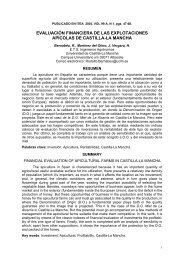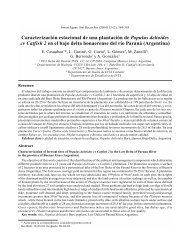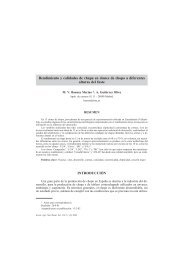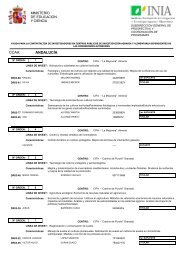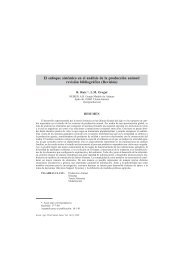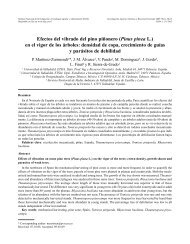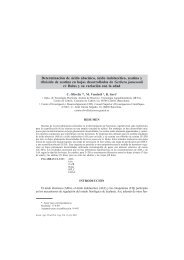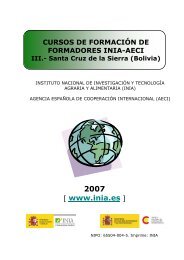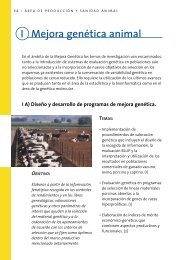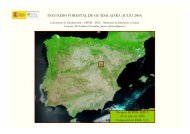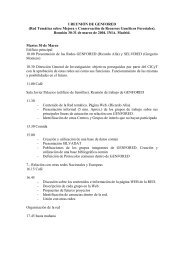Status of medicinal and aromatic plants in - Inia
Status of medicinal and aromatic plants in - Inia
Status of medicinal and aromatic plants in - Inia
Create successful ePaper yourself
Turn your PDF publications into a flip-book with our unique Google optimized e-Paper software.
124<br />
WORKING GROUP ON MEDICINAL AND AROMATIC PLANTS: FIRST MEETING<br />
In another study, a sample <strong>of</strong> 52 Origanum spp. were collected from 12 prov<strong>in</strong>ces situated<br />
<strong>in</strong> the Aegean <strong>and</strong> West Mediterranean regions <strong>of</strong> Turkey. Samples <strong>of</strong> 10 species<br />
(O. sipyleum L., O. onites L., O. majorana L., O. vulgare L., O. saccatum P.H.Davis,<br />
O. syriacum L., O. hypericifolium O.Schwarz & P.H.Davis, O. laevigatum Boiss. <strong>and</strong> O. bilgeri<br />
P.H.Davis) <strong>and</strong> two hybrids (O. sipyleum x O. vulgare subsp. hirtum, O. onites x O. vulgare<br />
subsp. hirtum) belong<strong>in</strong>g to Anatolican, Chilocalyx, Majarona, Prolaticorolla, Amaracus <strong>and</strong><br />
Origanum sections were <strong>in</strong>vestigated for 40 characters (Kıtıkı et al. 1997). The chromosome<br />
numbers <strong>of</strong> O. vulgare, O. sipyleum <strong>and</strong> O. onites were found as 2n=30. The samples could not<br />
be dist<strong>in</strong>guished by their cytological characters. Pr<strong>in</strong>cipal component analysis (PCA) was<br />
applied on morphological <strong>and</strong> anatomic characters. Accord<strong>in</strong>g to PCA results, the Anatolican<br />
section formed a dist<strong>in</strong>ct group from the ma<strong>in</strong> group which consists <strong>of</strong> other sections <strong>and</strong><br />
hybrids.<br />
A breed<strong>in</strong>g programme has been cont<strong>in</strong>ued on O. onites L. s<strong>in</strong>ce 1992. Initiation material<br />
was constituted by 5000 s<strong>in</strong>gle <strong>plants</strong> orig<strong>in</strong>at<strong>in</strong>g from different locations <strong>in</strong> western <strong>and</strong><br />
southwestern Turkey. Today, two groups <strong>of</strong> selected l<strong>in</strong>es consist<strong>in</strong>g <strong>of</strong> four <strong>and</strong> three l<strong>in</strong>es<br />
hav<strong>in</strong>g similar morphological <strong>and</strong> agronomic characters, high yield <strong>and</strong> quality, are grown<br />
to develop two synthetic l<strong>in</strong>es. There will be two commercial synthetic varieties <strong>in</strong> a few<br />
years.<br />
Sage (Salvia <strong>of</strong>fic<strong>in</strong>alis L.)<br />
The effect <strong>of</strong> nitrogen application (0, 80 <strong>and</strong> 160 kg/ha) <strong>and</strong> six different cropp<strong>in</strong>g systems<br />
on Salvia <strong>of</strong>fic<strong>in</strong>alis L. (common sage) were <strong>in</strong>vestigated <strong>in</strong> three locations for three years,<br />
between 1991 <strong>and</strong> 1993. Green herb, drug herb, drug leaf, essential oil %, essential oil yield,<br />
dry matter, plant height, plant nutrient composition (Mg, N, Na, K, Ca <strong>and</strong> P) <strong>and</strong><br />
composition <strong>of</strong> essential oil were exam<strong>in</strong>ed. Only the results for drug leaf yield <strong>and</strong> essential<br />
oil % are presented here (Table 3).<br />
Table 3. The effects <strong>of</strong> six plant<strong>in</strong>g patterns <strong>and</strong> three nitrogen levels on drug leaf yields <strong>and</strong> essential<br />
oil % <strong>of</strong> sage (Salvia <strong>of</strong>fic<strong>in</strong>alis L.)<br />
Drug leaf yield<br />
(kg/ha)<br />
Essential oil<br />
(%)<br />
Row space<br />
45 cm 70 cm 11.5 cm 22.5 cm 12.5 cm 25 cm Mean<br />
N 0 9560 7650 7510 7560 7550 7690 7920<br />
N 80 9350 7530 8860 8560 8680 8810 8630<br />
N 160 9400 7570 7850 8130 8040 8800 8300<br />
Mean 9440 7580 8070 8080 8090 8430 8280<br />
N 0 1.89 1.90 1.88 1.91 1.85 1.83 1.88<br />
N 80 1.83 1.81 1.89 1.85 1.87 1.96 1.87<br />
N 160 1.84 1.76 1.81 1.81 1.80 1.88 1.82<br />
Mean 1.85 1.82 1.86 1.86 1.84 1.89 1.85<br />
Lemon balm (Melissa <strong>of</strong>fic<strong>in</strong>alis L.)<br />
Eleven lemon balm (Melissa <strong>of</strong>fic<strong>in</strong>alis L.) populations orig<strong>in</strong>at<strong>in</strong>g from different sources <strong>in</strong><br />
Turkey <strong>and</strong> European countries were <strong>in</strong>vestigated for three years <strong>in</strong> two ecologically<br />
different locations, Menemen <strong>and</strong> Bozdağ, to f<strong>in</strong>d out the populations giv<strong>in</strong>g high quality<br />
<strong>and</strong> yield. There were significant variations between locations, years <strong>and</strong> populations for<br />
yield <strong>and</strong> quality characters. The ecology was highly suitable <strong>in</strong> Menemen to grow lemon<br />
balm successfully <strong>and</strong> almost all yield <strong>and</strong> quality characters at Menemen were significantly<br />
higher than those <strong>in</strong> Bozdağ (Table 4). The growth <strong>of</strong> populations <strong>in</strong> this study <strong>in</strong>creased<br />
after the first year <strong>of</strong> trials <strong>in</strong> both locations; therefore all aspects <strong>of</strong> yield were significantly<br />
higher <strong>in</strong> the second <strong>and</strong> third years <strong>of</strong> trials compared with the first year. The populations




